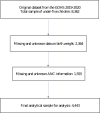Effect of antenatal care on birth outcomes in the Gambia: A propensity score matching analysis
- PMID: 40531806
- PMCID: PMC12176233
- DOI: 10.1371/journal.pgph.0003880
Effect of antenatal care on birth outcomes in the Gambia: A propensity score matching analysis
Abstract
The prevalence of low birth weight (LBW) remains disproportionately high in sub-Saharan Africa. LBW is a significant risk factor for infant mortality and is associated with long-term physical and cognitive impairments. While antenatal care (ANC) has the potential to improve birth outcomes, there is limited causal evidence on its impact in sub-Saharan settings. This study estimates the causal effects of ANC on birth weight and LBW in The Gambia using data from the 2019-20 Gambia Demographic and Health Survey (GDHS). The GDHS recorded birth weight for 8,362 children born in the five years preceding the survey; after excluding cases with missing data, the final analytical sample included 4,443 children. Multivariable regression and propensity score matching (PSM) methods were used to assess the relationship between ANC and birth outcomes, controlling for child sex and birth order, maternal age and education, household wealth, marital status, rural residence, number of children under five, and regional fixed effects. Multivariable regression estimates indicate that each additional ANC visit is associated with a 22-gram increase in birth weight and a 1.2 percentage point reduction in the likelihood of LBW. Mothers who attended four or more ANC visits (ANC 4+) had a 3.9 percentage point lower risk of delivering an LBW infant compared to those with fewer visits. PSM analysis corroborated these findings, showing that ANC 4 + was associated with a 71-gram increase in birth weight and a 4.7 percentage point reduction in LBW probability. These findings highlight the importance of health policies that promote adequate ANC coverage to reduce the high burden of LBW in resource-limited settings.
Copyright: © 2025 Gautam et al. This is an open access article distributed under the terms of the Creative Commons Attribution License, which permits unrestricted use, distribution, and reproduction in any medium, provided the original author and source are credited.
Conflict of interest statement
The authors have declared that no competing interests exist.
Figures
References
-
- World Health Organization and United Nations Children’s Fund (UNICEF): Low birthweight: country, regional and global estimates. [Mar; 2023}. 2004. https://apps.who.int/iris/handle/10665/43184
LinkOut - more resources
Full Text Sources
Miscellaneous



